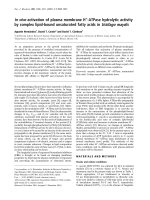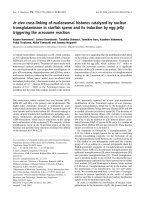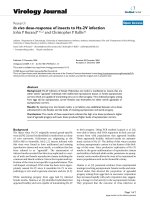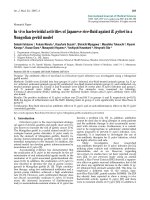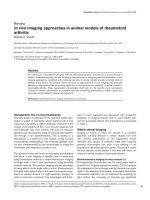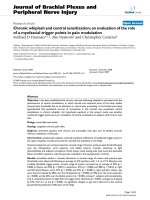Báo cáo y học: "In vitro and in vivo antitumor effects of acetylshikonin isolated from Arnebia euchroma (Royle) Johnst (Ruanzicao) cell suspension cultures" pps
Bạn đang xem bản rút gọn của tài liệu. Xem và tải ngay bản đầy đủ của tài liệu tại đây (1.13 MB, 7 trang )
BioMed Central
Page 1 of 7
(page number not for citation purposes)
Chinese Medicine
Open Access
Research
In vitro and in vivo antitumor effects of acetylshikonin isolated from
Arnebia euchroma (Royle) Johnst (Ruanzicao) cell suspension cultures
Wenbi Xiong, Gang Luo, Liming Zhou*, Yun Zeng and Wenji Yang
Address: Department of Pharmacology, West China Center for Medical Sciences, Sichuan University, Chengdu, Sichuan 610041, PR China
Email: Wenbi Xiong - ; Gang Luo - ; Liming Zhou* - ;
Yun Zeng - ; Wenji Yang -
* Corresponding author
Abstract
Background: Shikonin derivatives have cytotoxic and antitumor effects. This study aims to
investigate the antitumor effects of acetylshikonin isolated from a Chinese medicinal herb Arnebia
euchroma (Royle) Johnst.
Methods: The 3-(4,5-dimethylthiazol- 2-yl)-2,5-diphenyltetrazolium bromide (MTT) assay was
used to determine the in vitro antitumor effects of acetylshikonin on human lung adenocarcinoma
cell line A549, human hepatocellular carcinoma cell line Bel-7402, human breast adenocarcinoma
cell line MCF-7 and mouse Lewis lung carcinoma (LLC) cell line. C
57
BL/6 mice with LLC model
were used to study the in vivo antitumor effects of acetylshikonin. The expression of bax, bcl-2 and
caspase-3 proteins in LLC tissue was determined with immunohistochemical staining.
Results: In A549, Bel-7402, MCF-7 and LLC cell lines, acetylshikonin inhibited cell growth in a
dose-dependent manner. IC50 (means ± SD) were 5.6 ± 0.86 μg/ml, 6.82 ± 1.5 μg/ml, 3.04 ± 0.44
μg/ml and 2.72 ± 0.38 μg/ml respectively. Acetylshikonin suppressed tumor growth in C57BL/6
mice with LLC. The inhibition rate of acetylshikonin (2 mg/kg) was 42.85%. Immunohistochemical
staining revealed that in the acetylshikonin groups the expression of bax and caspase-3 increased,
whereas the expression of bcl-2 decreased, suggesting that acetylshikonin induced tumor cell
apoptosis through activating the pro-apoptotic bcl-2 family and caspase-3.
Conclusion: Acetylshikonin isolated from Arnebia euchroma (Royle) Johnst cell suspension cultures
exhibits specific in vivo and in vitro antitumor effects.
Background
Arnebia euchroma (Royle) Johnst (Ruanzicao), a Chinese
medicinal herb that induces apoptosis and exerts antitu-
mor effects, is used to treat inflammatory diseases and
cancer [1]. Shikonin derivatives, e.g. shikonin, ace-
tylshikonin (Figure 1), β, β-dimethyl-acrylshikonin, are
active components in Arnebia euchroma (Royle) Johnst.
Natural shikonin-like compounds have in vitro inhibitory
effects on malignant carcinoma cells. Zhen et al. [2]
showed that shikonin induced apoptosis of human malig-
nant melanoma A375-S2 cells via activated p53 and cas-
pase-9 pathways. Yoon et al. [3] found that shikonin
induced HL60 cells apoptosis via caspase-3 dependent
pathways. Gao et al. [4] reported that shikonin reacted
with cellular thiols such as glutathione, and that the
depletion of cellular thiols induced apoptosis in HL60
Published: 11 July 2009
Chinese Medicine 2009, 4:14 doi:10.1186/1749-8546-4-14
Received: 25 September 2008
Accepted: 11 July 2009
This article is available from: />© 2009 Xiong et al; licensee BioMed Central Ltd.
This is an Open Access article distributed under the terms of the Creative Commons Attribution License ( />),
which permits unrestricted use, distribution, and reproduction in any medium, provided the original work is properly cited.
Chinese Medicine 2009, 4:14 />Page 2 of 7
(page number not for citation purposes)
cells. Natural shikonin-like compounds also have signifi-
cant in vivo antitumor effects. In a study by He et al. [5],
SYUNZ-7, a shikonin derivative, showed antitumor effects
both in vivo and in vitro. Xie et al. [6] showed that some
shikonin derivatives were more powerful than natural
shikonin in terms of antitumor effects on EAC and S180.
Kim et al. [7] reported that 2-hyim-DMNQ-S33, another
shikonin derivative, prolonged the survival time of mice
bearing S180.
Due to limited distribution and difficult cultivation of
Arnebia euchroma (Royle) Johnst, we used the vegetal cell
suspension culture technique for the biosynthesis of
shikonin-like compounds. Two compounds, namely ace-
tylshikonin and isobutyrylshikonin, have been isolated
from the culture vegetal cell suspension.
This study aims to evaluate the in vivo and in vitro antitu-
mor effects of acetylshikonin extracted from the cell sus-
pension cultures of Arnebia euchroma (Royle) Johnst.
Methods
Materials
Acetylshikonin extract was obtained from Huakang Phar-
maceutical (China) and was confirmed by high-perform-
ance liquid chromatography (HPLC). 3-(4,5-
dimethylthiazol- 2-yl)-2,5-diphenyltetrazolium bromide
(MTT) was obtained from Sigma Chemical (USA). Cyclo-
phosphamide was obtained from Hengrui Pharmaceuti-
cal (China).
Cell lines and cell culture
Malignant cell lines in this study include human lung ade-
nocarcinoma epithelial cell line A549 (ATCC CCL-185),
human breast adenocarcinoma cell line MCF-7 (ATCC
HTB-22TM) and mouse Lewis lung carcinoma (LLC)
(ATCC CRL-1642) were obtained from American Type
Culture Collection (USA). Human hepatocellular carci-
noma cell line Bel-7402 was obtained from the Cell Bank
of the Chinese Academy of Sciences. The cells were cul-
tured in RPMI 1640 (Gibco, USA) supplemented with
10% fetal bovine serum (Minhai Bio-engineering, China)
and maintained at 37°C with 4% CO
2
in a humidified
atmosphere. Cell viability was determined with 0.1%
trypan blue.
MTT assay
MTT assay [2] was performed to measure the anti-prolifer-
ation effects of acetylshikonin on the cell lines of A549,
Bel-7402, MCF-7 and LLC. Acetylshikonin was diluted
and added to target cells in triplicates with final concen-
trations at 25.6, 12.8, 6.4, 3.2, 1.6, 0.8, 0.4 μg/ml. The
cells were incubated for 48 hours and 20 μl of 5 mg/ml
solution of MTT in phosphate-buffered saline (PBS) was
added to triplicate samples and the plates were incubated
for additional 4 hours. The plates were then centrifuged
and the medium was removed. Two hundred microliters
(200 μl) of DMSO was added to each well to dissolve the
purple blue sediment, the absorbance was determined at
590 nm on a microplate reader (Model 550, Bio-Rad,
USA). The inhibition rate was calculated as follows:
The 50% inhibitory concentrations (IC
50
) of the 48 hours
were calculated with Bliss assay.
Cell growth curve assay
Similarly, A549 cell was used to observe the effects of ace-
tylshikonin on growth curve at various time points. Ace-
tylshikonin was added to A549 cell with various final
concentrations (3.2, 1.6, 0.8 μg/ml). MTT assay was per-
formed on the cells in triplicates for each concentration
after the cells were incubated for 12, 24, 48, 72 hours
respectively. Adriamycin (0.1 μg/ml) served as a positive
control.
Mouse model preparation and treatment
The C
57
BL/6 mice (Experimental Animal Center, West
China Center for Medical Sciences, Sichuan University,
China) were transplanted with LLC according to protocols
of transplanted tumor research. At 24 hours after tumor
transplantation, the mice were divided into five groups
(12 mice per group) randomly: (1) control group (0.9%
normal saline), (2) cyclophosphamide group (60 mg per
kg of body weight), (3) acetylshikonin group (0.5 mg per
kg of body weight), (4) acetylshikonin group (1 mg per kg
of body weight) and (5) acetylshikonin group (2 mg per
kg of body weight). Mice in cyclophosphamide group
received injections only on Day 1, while mice in all other
groups received injections once every two days (six times
in total). All injections were carried out intraperitoneally.
Data were collected and calculated as follows:
(1) Tumor volume: The length (A) and width (B) of the
tumor were measured of the tumor issue of each mouse
once every two days since Day 5. Tumor volume (V) =
AB
2
/2
Inhibition rate absorbance of treatment group absorb(%) ( /=−1aance of control group) %× 100
Chemical structures of acetylshikonin (I) and shikonin (II)Figure 1
Chemical structures of acetylshikonin (I) and
shikonin (II).
C
18
H
18
O
6
MW: 330.3 CAS#: 24502-78-1
C
16
H
16
O
5
MW:288.3 CAS#: 517-89-5
Chinese Medicine 2009, 4:14 />Page 3 of 7
(page number not for citation purposes)
(2) Inhibitory rate: The animals were sacrificed on Day 13
and tumors were exercised and weighed. Tumor inhibi-
tion rate (%) = (1- tumor tissue weight of treatment
group/tumor tissue weight of control group) ×100%
The animal handlings and experimental procedures were
approved by the Animal Ethics Committee of Sichuan
University.
Immunohistochemistry
Tumor tissues were fixed with 4% formaldehyde solution
at 4°C for 24 hours, dehydrated in graded concentrations
of ethanol embedded in paraffin and sliced.
Streptavidin/biotin-peroxidase (SP) method was used for
immunohistochemical staining. The primary antibodies,
namely bcl-2, bax and caspase-3 (Wuhan Boster Biologi-
cal Technology, China), were diluted at 1:100. PBS was
used as control. Each slice was photographed and the inte-
grated optical density (IOD) was measured with Image
pro plus 5.02 (Media Cybernetics, USA).
Statistical analysis
Data were expressed as mean ± standard deviation (SD)
unless otherwise indicated. Statistical differences between
the treatment and control groups were determined by
Mann-Whitney test with SPSS 12.0 (SPSS, USA). P < 0.05
was considered statistically significant.
Results
In vitro effects of acetylshikonin on tumor cell viability
After treatment with acetylshikonin for 48 hours, the
untreated tumor cells grew and the cytoskeletons were
clearly visible under inverted light microscope. Cells
treated with 25.6 μg/ml acetylshikonin became round in
shape and condensed nuclei were seen, many of which
lost intact membranes, leading to necrosis (Figure 2).
Cell inhibition rates were determined by MTT assay. The
results revealed that acetylshikonin inhibited the growth
of A549, Bel-7402, MCF-7 and LLC in a dose-dependent
manner. IC
50
for 48 hours were 5.6 ± 0.86 μg/ml, 6.82 ±
1.5 μg/ml, 3.04 ± 0.44 μg/ml and 2.72 ± 0.38 μg/ml
respectively (Figure 3). Acetylshikonin inhibited the
growth of A549 in a time-dependent manner as indicated
in the growth curve (Figure 4).
Effects of acetylshikonin on tumor volume
Since Day 5, significant differences were observed
between the control and cyclophosphamide and ace-
tylshikonin groups. Tumor volume of the mice in the
cyclophosphamide group increased slowly, suggesting
that the growth of LLC was suppressed by cyclophospha-
mide. Tumor volume of the mice in the acetylshikonin
group (2 mg/kg) was markedly smaller than that in the
control group, suggesting that the growth of LLC was sup-
pressed by acetylshikonin (Figure 5).
Acetylshikonin induced morphological changes of tumor cells (×200)Figure 2
Acetylshikonin induced morphological changes of tumor cells (×200). (A) A549 control; (B) A549 treated with 25.6
μg/ml acetylshikonin; (C) Bel-7402 control; (D) Bel-7402 treated with 25.6 μg/ml acetylshikonin; (E) MCF-7 control; (F) MCF-7
treated with 25.6 μg/ml acetylshikonin; (G) LLC control; (H) LLC treated with 25.6 μg/ml acetylshikonin.
$
$
$
$&
&
&
&(
(
(
(*
*
*
*
%
%
%
%
'
'
'
'
)
)
)
)
+
+
+
+
Chinese Medicine 2009, 4:14 />Page 4 of 7
(page number not for citation purposes)
Inhibitory rate on LLC
Cyclophosphamide and acetylshikonin (1, 2 mg/kg) had
significant inhibitory effects on the growth of LLC in mice.
Inhibitory rate of the cyclophosphamide group was
67.81%; inhibition rates of the three acetylshikonin
groups were 42.85%, 21.86% and 11.11% respectively, all
in a dose-dependent manner (Table 1, Figure 6).
Immunohistochemistry evaluation
The photomicrograph of immunohistochemistry staining
is shown in Figure 7. The positive reaction located in
cytosol was stained in brown. The color of the stain is pos-
itively correlated to the protein expression.
The IOD of each group indicates that the expression of bax
and caspase-3 in the acetylshikonin groups increased,
whereas bcl-2 decreased in the same groups, resulting in
higher bax/bcl-2 ratios, all in a dose-dependent manner
(Table 2).
Discussion
Recent studies showed that shikonin derivatives acted on
multiple tumor cells and triggered multiple cell death
pathways. Therefore, shikonin derivatives are potential
cancer treatment agents. Acetylshikonin is a main
shikonin derivative of Arnebia euchroma (Royle) Johnst.
Other research on shikonin derivatives also demonstrated
that acetylshikonin inhibited K562 and HL-60 tumor
growth [8]; however, acetylshikonin had not been studied
in detail. The present study indicated that acetylshikonin
Inhibitory effects of acetylshikonin on the growth of tumor cells (n = 3)Figure 3
Inhibitory effects of acetylshikonin on the growth of
tumor cells (n = 3).
acetylshikonin
˄
μg/ml
˅
Inhibition rate
˄
%
˅
$
%HO
0&)
//&
Inhibitory effects of acetylshikonin on the growth of A549 determined by cell growth curve assay (n = 3)Figure 4
Inhibitory effects of acetylshikonin on the growth of
A549 determined by cell growth curve assay (n = 3).
0
0.1
0.2
0.3
0.4
0.5
0.6
0.7
0.8
0 12244872
time(h)
The value of OD
590
nm
Adriamycin 0.1 mg/L
Acetylshikonin 0.8 mg/L
Acetylshikonin 1.6 mg/L
Acetylshikonin 3.2 mg/L
Control
Inhibitory effects of acetylshikonin and cyclophosphamide on mouse tumor volumeFigure 5
Inhibitory effects of acetylshikonin and cyclophospha-
mide on mouse tumor volume.
7LPHG
7XPRUYROXPH˄F
FRQWURO
F\FORSKRVSKDPLGH
P
˅
DFHW\OVKLNRQLQPJNJ
DFHW\OVKLNRQLQPJNJ
DFHW\OVKLNRQLQPJNJ
Effects of acetylshikonin and cyclophosphamide on average tumor weights of LLC in mice (n = 12)Figure 6
Effects of acetylshikonin and cyclophosphamide on
average tumor weights of LLC in mice (n = 12). (1)
control; (2) cyclophosphamide; (3) acetylshikonin (2 mg/kg);
(4) acetylshikonin (1 mg/kg); (5) acetylshikonin (0.5 mg/kg).
Acetylshikonin (1 mg/kg, 2 mg/kg) and cyclophosphamide sig-
nificantly inhibited the growth of LLC. *P < 0.05, ***P <
0.0001, vs. control.
Chinese Medicine 2009, 4:14 />Page 5 of 7
(page number not for citation purposes)
had in vitro and in vivo antitumor effects. Acetylshikonin
possessed a high level of cytotoxic activity in vitro. The
present study showed that tumor volume and weight of
the mice treated with acetylshikonin increased more
slowly than the control in vivo.
Apoptosis is critical in the development of tumor. Anti-
apoptotic agents such as bcl-2 are initially integral mem-
brane proteins in mitochondria, endoplasmic reticulum
(ER) or nuclear membrane [9]. These agents inhibit apop-
tosis by regulating Ca
2+
fluxes through ER membrane [10].
Over expression of bcl-2 turns cells suffering from irrevers-
ible gene mutation to normal cell cycle rather than apop-
tosis, thereby causing cancer. In contrast, bax is a pro-
apoptotic molecule that can induce cell apoptosis. In via-
ble cells, bax is either in the cytosol or loosely attached to
membranes. In response to a death stimulus, the cytosolic
bax translocates to mitochondria where it becomes an
integral membrane protein and cross-linkable as
homodimers, creating a pathway for cytochrome c to
release and activate caspase [11]. As the bcl-2 family pro-
teins act upstream from irreversible cellular damage and
all have effects in mitochondria, the ratio of bcl-2 and bax
determines whether a cell will live or die [12]. Apoptosis
Table 1: Inhibitory effects of cyclophosphamide and acetylshikonin on the growth of LLC
Weight of tumor (g)
Group
(n = 12)
Dose
(mg/kg)
Inhibition rate (%) Mean SD Percentiles
25th 50th (median) 75th
Control - - 1.368 0.388 1.070 1.229 1.718
Cyclophosphamide 60 × 1 67.81 0.440 0.084 0.371 0.415*** 0.523
2 × 6 42.85 0.782 0.154 0.634 0.790*** 0.946
Acetylshikonin 1 × 6 21.86 1.067 0.214 0.850 1.010* 1.273
0.5 × 6 11.11 1.307 0.364 0.962 1.376 1.640
* P < 0.05, ***P < 0.001, vs. control
Bax, bcl-2 and caspase-3 protein expression in LLC tissues (×400)Figure 7
Bax, bcl-2 and caspase-3 protein expression in LLC tissues (×400). (A) Bax control; (B) Bax acetylshikonin (2 mg/kg);
(C) Bcl-2 control; (D) Bcl-2 acetylshikonin (2 mg/kg); (E) caspase-3 control; (F) caspase-3 acetylshikonin (2 mg/kg).
$
$
$
$
&
&
&
&
(
(
(
(
%
%
%
%
'
'
'
'
)
)
)
)
Chinese Medicine 2009, 4:14 />Page 6 of 7
(page number not for citation purposes)
manifests in two major execution programs downstream
from the death signal: the caspase pathway and organelle
dysfunction, mitochondrial dysfunction in particular.
Caspases play an essential role during apoptotic cell
death. There are two relatively well characterized caspase
cascades: one is initiated by the activation of cell-surface
death receptors, such as Fas and tissue necrosis factor,
leading to caspase-8 activation which in turn cleaves and
activates downstream caspases; the other is triggered by
cytochrome c released from mitochondria, which pro-
motes the activation of caspase-9 and caspase-3, thereby
initiating caspase cascade to induce cell apoptosis [13].
Our results suggest that acetylshikonin activates the pro-
apoptotic bcl-2 family, releases cytochrome c and acti-
vates caspase-3, thereby inducing tumor cell apoptosis.
Hsu et al. [14] found that shikonin activated caspase and
induced apoptosis via modulating bcl-2 family, p27 and
p53. Liu et al. [15] found that certain shikonin derivatives
(acetylshikonin) act as modulators of the Nur77-medi-
ated apoptotic pathway and identify a new shikonin-
based lead that targets Nur77 for apoptosis induction.
Xuan and Hu [8] reported that Shikonin derivatives cir-
cumvented diverse cancer drug resistance (P-gp, MRP1,
BCRP1, Bcl-2, Bcl-xL) by inducing a dominant necrosis.
Apart from inducing apoptosis, acetylshikonin may also
inhibit DNA topoisomerase, reduce carcinogenesis and
possess antimitogenic and angiogenic actions [16,17]. As
a possible wide spectrum agent combating cancer through
various mechanisms, acetylshikonin may be a therapeutic
candidate.
Conclusion
Acetylshikonin isolated from Arnebia euchroma (Royle)
Johnst cell suspension cultures exhibits specific in vivo and
in vitro antitumor effects.
Abbreviations
A549: human lung adenocarcinoma cell line A549; Bcl-2:
B cell lymphoma/lewkmia-2; bax: Bcl-2 associated X pro-
tein; Bcrp1: breast cancer resistance protein; Bel-7402:
human hepatocellular carcinoma cell line Bel-7402;
DMSO: dimethyl sulfoxide; EAC: mice Ehrlich ascitic car-
cinoma; ER: endoplasmic reticulum; HL60: human pro-
myelocytic leukemia cell line; IC
50
: 50% inhibitory
concentrations; IOD: integrated optical density; LLC:
Lewis lung carcinoma; MCF-7: human breast adenocarci-
noma cell line MCF-7; MRP1: multi-drug resistance pro-
tein 1; MTT: 3-(4,5-dimethylthiazol-2-yl)-2,5-
diphenyltetrazolium bromide; PBS: phosphate buffered
saline; P-gp: P-glycoprotein; S180: C57BL/6 mice fibrosa-
rcoma cell line; SD: standard deviation.
Competing interests
The authors declare that they have no competing interests.
Authors' contributions
LMZ and WBX conceived the study design and drafted the
manuscript. GL, YZ and WJY conducted the experiments
Table 2: Bax, bcl-2 and caspase-3 expression (in IOD) in tumor tissues of LLC in mice
Percentiles
Group
(n = 10)
Dose
(mg/kg)
Mean SD 25th 50th (median) 75
th
Bax
Control - 13633 2531 11244 13712 15634
Acetylshikonin 2 × 6 48678 2534 46432 48519*** 51406
1 × 6 28502 5064 23628 30232*** 33082
0.5 × 6 21844 4882 16476 22988** 26209
bcl-2
Control - 19859 2822 17076 20065 22292
Acetylshikonin 2 × 6 8126 1115 7267 7926*** 8596
1 × 6 11171 1459 9916 10814*** 12478
0.5 × 6 15652 1724 14447 15234** 16742
Bax/bcl-2
Control - 0.70 0.17 0.58 0.74 0.79
Acetylshikonin 2 × 6 6.11 0.92 5.54 6.05*** 6.26
1 × 6 2.56 0.36 2.34 2.47*** 2.77
0.5 × 6 1.41 0.32 1.14 1.29** 1.77
Caspase-3
Control - 12746 3155 10359 12019 13714
Acetylshikonin 2 × 6 31618 3155 29396 31226*** 33530
1 × 6 22653 4647 18898 21756*** 25119
0.5 × 6 13582 3737 10009 13186 17705
** P < 0.01, *** P < 0.001, vs. control
Publish with BioMed Central and every
scientist can read your work free of charge
"BioMed Central will be the most significant development for
disseminating the results of biomedical research in our lifetime."
Sir Paul Nurse, Cancer Research UK
Your research papers will be:
available free of charge to the entire biomedical community
peer reviewed and published immediately upon acceptance
cited in PubMed and archived on PubMed Central
yours — you keep the copyright
Submit your manuscript here:
/>BioMedcentral
Chinese Medicine 2009, 4:14 />Page 7 of 7
(page number not for citation purposes)
and performed the data analysis. All authors read and
approved the final version of the manuscript.
Acknowledgements
This study was supported by the Natural Science Foundation of Sichuan
Province, China (No.02SY029-137).
References
1. Huang H, Liu ZC: Anticancer effect of shikonin and derivatives.
Zhongliu Fangzhi Zazhi 2005, 12:75-78.
2. Wu Z, Wu LJ, Li LH, Tashiro S, Onodera S, Ikejima T: p53-mediated
cell cycle arrest and apoptosis induced by shikonin via a cas-
pase-9-dependent mechanism in human malignant
melanoma A375-S2 cells. J Pharmacol Sci 2004, 94:166-176.
3. Yoon Y, Kim YO, Lim NY, Jeon WK, Sung HJ: Shikonin, an ingre-
dient of Lithospermum erythrorhizon induced apoptosis in
HL60 human premyelocytic leukemia cell line. Planta Med
1999, 65:532-535.
4. Gao DY, Hiromura M, Yasui H, Sakurai H: Direct reaction
between shikonin and thiols induces apoptosis in HL60 cells.
Biol Pharm Bull 2002, 25:827-832.
5. Huang H, Xie BF, Zhu XF, Feng GK, Zhou JM, Wang Y, Wu HQ,
Huang ZS, Gu LQ, Liu ZC: Anticancer Effect and Mechanism of
Shikonin Derivative SYUNZ-7. Aizheng 2005, 24:1453-1458.
6. Xie BF, Feng GK, Huang H, Zhu XF, Zhou JM, Wang Y, Liu ZC, Wu
HQ, Huang ZS, Gu LQ: Investigation of anticancer effect of nat-
ural radix arnebiae seu lithospermi naphthoquinone com-
pounds and its derivatives. Zhongguo Yaolixue Tongbao 2006,
22:505-507.
7. Kim SH, Kang IC, Yoon TJ, Park YM, Kang KS, Song GY, Ahn BZ:
Anticancer activities of a newly synthesized shikonin deriva-
tive, 2-hyim-DMNQ-S-33. Cancer Lett 2001, 172:171-175.
8. Xuan Y, Hu X: Naturally-occurring shikonin analogues-A class
of necroptotic inducers that circumvent cancer drug resist-
ance. Cancer Lett 2009, 18;274(2):233-42.
9. Korsmeyer SJ, Wei MC, Saito M, Weiler S, Oh KJ, Schlesinger PH:
Pro-apoptotic cascade activates BID, which oligolnerizes
BAK or BAX into pores that result in the release of cyto-
chrome c. Cell Death Differ 2000, 7:1166-1173.
10. Lee JU, Hosotani R, Wada M, Doi R, Kosiba T, Fujimoto K, Miyamoto
Y, Tsuji S, Nakajima S, Nishimura Y, Imamura M: Role of Bcl-2 fam-
ily proteins (Bax, Bcl-2 and Bcl-x) on cellular susceptibility to
radiation in pancreatic cancer cells. Eur J Cancer. 1999,
35(9):1374-1380.
11. Nicholson DW: Caspase structure, proteolytic substrates, and
function during apoptotic cell death. Cell Death Differ 1999,
6:1028-1042.
12. Fan TJ, Han LH, Cong RS, Liang J: Caspase family proteases and
apoptosis. Acta Biochim Biophys Sin 2005, 37:719-727.
13. Zou H, Li Y, Liu X, Wang X: An APAF-1 cytochrome c mul-
timeric complex is a functional apoptosome that activates
procaspase-9. J Biol Chem 1999, 274(17):11549-11556.
14. Hsu PC, Huang YT, Tsai ML, Wang YJ, Lin JK, Pan MH: Induction of
apoptosis by shikonin through coordinative modulation of
the Bcl-2 family, p27, and p53, release of cytochrome c, and
sequential activation of caspases in human colorectal carci-
noma cells. J Agric Food Chem 2004, 52:6330-6337.
15. Liu J, Zhou W, Li SS, Sun Z, Lin B, Lang YY, He JY, Cao X, Yan T,
Wang L, Lu J, Han YH, Cao Y, Zhang XK, Zeng JZ: Modulation of
orphan nuclear receptor Nur77-mediated apoptotic path-
way by acetylshikonin and analogues. Cancer Res 2008,
68:8871-8880.
16. Chen X, Yang L, Oppenheim JJ, Howard MZ: Cellular Pharmacol-
ogy Studies of Shikonin Derivatives. Phytother Res 2002,
16:199-209.
17. Lee HJ, Lee HJ, Magesh V, Nam D, Lee EO, Ahn KS, Jung MH, Ahn KS,
Kim DK, Kim JY, Kim SH: Shikonin, acetylshikonin, and isobuty-
roylshikonin inhibit VEGF-induced angiogenesis and sup-
press tumor growth in lewis lung carcinoma-bearing mice.
Yakugaku Zasshi 2008, 128:1681-1688.
